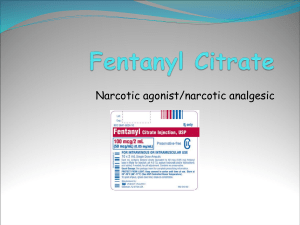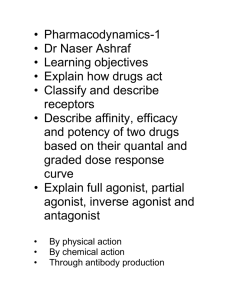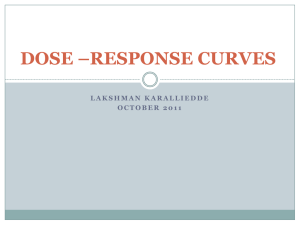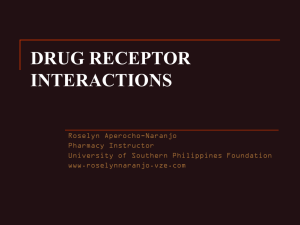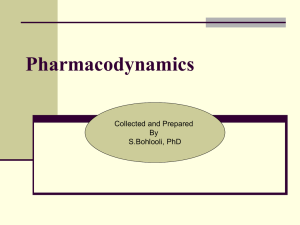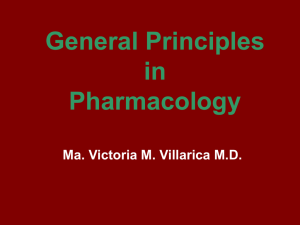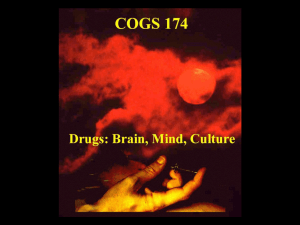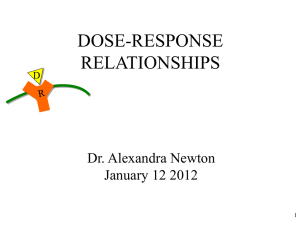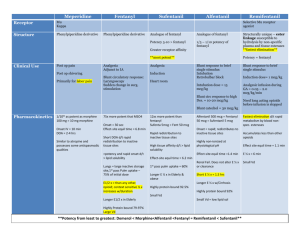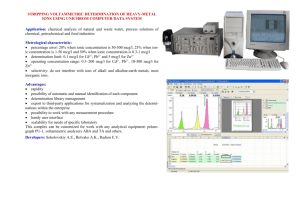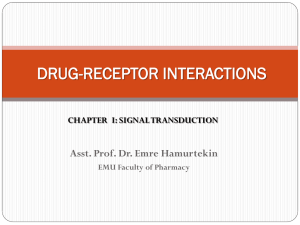Opiods flash cards - dan
advertisement
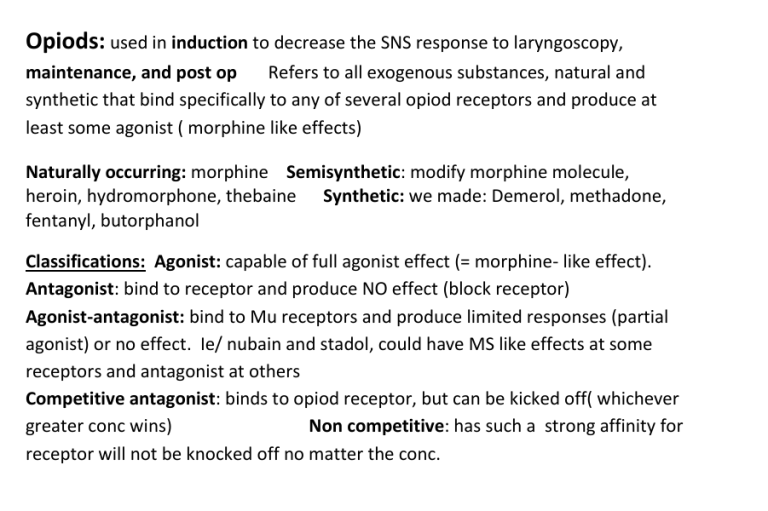
Opiods: used in induction to decrease the SNS response to laryngoscopy,
maintenance, and post op
Refers to all exogenous substances, natural and
synthetic that bind specifically to any of several opiod receptors and produce at
least some agonist ( morphine like effects)
Naturally occurring: morphine Semisynthetic: modify morphine molecule,
heroin, hydromorphone, thebaine Synthetic: we made: Demerol, methadone,
fentanyl, butorphanol
Classifications: Agonist: capable of full agonist effect (= morphine- like effect).
Antagonist: bind to receptor and produce NO effect (block receptor)
Agonist-antagonist: bind to Mu receptors and produce limited responses (partial
agonist) or no effect. Ie/ nubain and stadol, could have MS like effects at some
receptors and antagonist at others
Competitive antagonist: binds to opiod receptor, but can be kicked off( whichever
greater conc wins)
Non competitive: has such a strong affinity for
receptor will not be knocked off no matter the conc.
Mechanism of Action: block the transmission of pain by acting as agonists at opiod
receptor sites. These receptors are found in dorsal horn of spinal cord , brain and
peripheral tissues.
Endogenously, these receptors would be activated by Endorphins, Enkephalins,
and Dynorphins
Opiods mimic the action s of these endogenous ligands by binding to the opiod
receptors , activating the pain modulating systems.
The principle effect of activating the opiod receptor is decrease in
neurotransmission, primarily by a decrease in presynaptic neurotransmitter release
{Opiod receptor activation inhibits the presynaptic release and post synaptic
response to excitatory neurotransmitters ( Ach) from nocioceptive neurons
Small molecular changes can convert agonist to antagonist, Levo L isomer more
potent than dextro- D
OPIOD RECEPTORS: not discovered until 1970
Initially thought to be Mu, Kappa, Sigma Now: Mu, delta, kappa, (sigma not
considered opiod receptor anymore)
Each receptor had a different function, but primarily work on mu1 and mu2 ( in
Substantia Gelatinosa
Mu1 :supraspinal( brain) and spinal analgesia, Euphoria, Miosis and urinary
retention
Mu2: primarily spinal analgesia, Respiratory Depression ( primary), physical
dependence, constipation, bradycardia.
Kappa: Analgesia (spinal/ supraspinal), sedation, dysphoria (ie. Ketamine)
Delta: Spinal (mostly), supraspinal analgesia, some respiratory depression and
physical dependence
Characteristics common to all opiods:
Dose dependent ventilatory depression: decreased rate with ^ TV, and decreased
response to ^ CO2
Do not reliably produce unconsciousness: most cause sedation, but primary
effect is analgesia
May stimulate the chemoreceptor trigger zone: Nausea and vomiting, is in 4th
ventricle of the brain stem
Cause spasm of the biliary smooth muscle (sphincter of Oddi): can treat this with
nitro, atropine, narcan , glucagon and benadryl
Morphine
The prototype opiod agonist to which all others are compared ( E1/2 = 1.5-3hrs)
Dose: intraop: 0.1-1 mg/kg IV ( use the larger doses with big painful surgery
(thoracotomy)
Post op: .05-0.2 mg/kg IM / .03-.015 mg/kg IV
Major feature: Histamine release decreased BP, increased HR, flushing, and
bronchospasm ( not for asthmatics). Give slow will help to decrease the histamine
release (Treat with vasodilators or volatiles)
Broken down to Active Metabolites: Morphine 3 and morphine 6 glucuronide. The
6 is more potent and longer acting agonist than morphine
Metabolism : biotransformed by the liver, excreted by the kidneys ( problems then
exist with renal failure pts) will have greater MS 6 in body
Merperdine/ Demerol
The 1st Completely synthetic Opiod
1/10 potency of MSO4
E1/2= 3-5 hrs
Dose: 0.5mg/kg IM 0.2-0.5mg/kg IV ( not usually used intraop)
Structurally similar to atropine will ^ HR and cause mydriasis
Used to decrease Post op shivering- mechanism is unclear, but thought to be due
to stimulation of kappa receptors, decrease shiver threshold, acts as an agonist
atAlpha 2 receptors ( could also use clonidine)
Breaks down into normeperdine, which is neurotoxic in hi conc’s and bad esp if
using PCA or infusions of it. Also excreted by kidneys. Could cuase seizures and
myoclonus
DO NOT GIVE TO PT’s ON MAOI’s: causes a severe excitatory state: increased HR,
BP, T, delirium, seizures and possibly death
Fentanyl/ Sublimaze
Structurally related to merperdine , is cheap.
E ½ = 3- 6 hrs
100 X more potent than MS
Always mixed 1cc= 50 mcg
Dose: Intraop: 2- 10 mcg/kg CT surgery: 30- 50 mcg/kg
post op: 0.5-1.5 mcg/kg
Minimal CV depressant effects ( good with CV surgery), may decrease HR
Can Cause Chest Wall Rigidity tx this with paralytic if unable to ventilate or open
heart surgery where want chest muscles relaxed
Is very addicting ( if take this when not in pain, will be addicted)
Can have oral : fentanyl lollipop
Low molecular wt and ^ lipid solubility allows for transdermal absorption
Sufentanyl
7-10 X more potent than fentanyl
E ½ = 2 ½ - 3 ½ hrs ^$
Dose: Intraop 0.2-0.8 mcg/kg CT surgery 10- 30 mcg/kg
Alfentanyl
1/5- 1/10 as potent as fentanyl
Dose: Intraop 10 – 100 mcg/kg
Chest wall rigidity
E ½ = 1 ½ hrs
Chest wall rigidity
More rapid onset , but shorter duration than fentanyl or sufenta
Remifentanyl
similar potency to fentanyl E ½ = 15- 30 min
Extremely rapid onset, clearance and recovery ( the sux of opiods) Fast on, fast off,
if use as an infusion once turn it off it is gone., no more analgesic effects
Dose: 1 mcg/kg IV over 60 -90 sec, then 0.25 – 1 mcg/kg OR 0.05 – 2 mcg/kg/ min
Metabolized by non-specific plasma and tissue esterases
Antagonists: (block the opiod receptor)
NARCAN /NALOXONE: most frequently used antagonist in anesthesia
Great affinity for the Mu receptors and is a competitive antagonist ( don’t want a
non competitive)
Can reverse unconsciousness from narcotic overdose
Reverses respiratory depression: give in 20 – 40 mcg increments
ampule( 0.4mg) with 9 cc of NS and give 1 cc at a time ( 40ug/cc)
Mix: one
Given at this dosage will recerse resp depression ( Mu-2) and can maintain
analgesia. Peaks in 1- 2 minutes and lasts 30 – 45 min. ( IS COMPETITIVE SO PT
CAN BECOME APNEIC AGAIN)
Abrupt reversal can cause excessive SNS stimulation: Arrythmias ( V fib), ^ HR, ^
BP, n& V, and pulmonary edema ( Not with CAD pt’s, cause MI) If No opiod on
board , can still have the SNS effects
Naltrexone/ Trexan
is po
Longer acting antagonist given po for addicts, Unlike narcan that is not effective po
Can last up to 24 hrs
narcotics
Pt’s on this preop can have a temporary resistance to
Agonist/ Antagonists: partial agonists
Butorphanol/ Stadol;
produces analgesia and resp depression similar ot 10
mg of MSO4
Causes more sedation than nubain. Incidence of dysphoria is low
Does not increase intrabiliary pressure and can be used to treat post op shivering
Dose: 0.5- 3 mg IV
Nalbuphine/ Nubain
Best described as a partial agonist at kappa and mu receptors (used in OB)
MS like analgesia, may cause some sedation but not as much as stadol
Given IV can reverse the resp depressant effects of the narcotic, but sustain the
analgesia ( better to use than narcan cause does not bump opiod off the receptor)
Also used to antagonize itching from epidural and intrathecal MSO4
May be given IV or IM Dose: 5- 10 mg
Can cause withdrawl symptoms in pts addicted to opiods
Flumazenil / Romazicon Not an opiod antagonist
A benzodiazepine antagonist (competitive)
Reversed anesthetic effects of benzo’s partially or completely depending on the
dose. Has a high affinity for the benzo receptor, but minimal intrinsic activity
Dose: usually given in 0.2mg increments until desired effect is achieved. Usual
total dose does not exceed 1 mg
